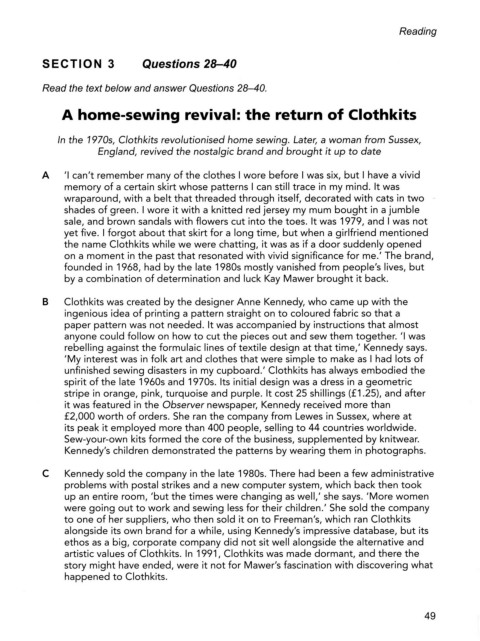Page 344 - Cam General 15-16-17-18-19
P. 344
Reading
SECTION 3 Questions 2ι40
Read the text below and answer Questions 28-40.
A home-sewing revival: the return of Clothkits
In the 1970s, Clothkits revolutionised home sewing. Later, a woman from Sussex,
England, revived the nostalgic brand and brought it up to date
A ’I can’t remember many of the clothes I wore before I was six, but I have a vivid
memory of a certain skirt whose patterns I can still trace in my mind. It was
wraparound, with a belt that threaded through itself, decorated with cats in two
shades of green. I wore it with a knitted red jersey my mum bought in a jumble
sale, and brown sandals with flowers cut into the toes. It was 1979, and I was not
yet five. I forgot about that skirt fo「 a long time, but when a girlfriend mentioned
the name Clothkits while we were chatting, it was as if a door suddenly opened
on a moment in the past that resonated with vivid significance for me.’ The brand,
founded in 1968, had by the late 1980s mostly vanished from people’s lives, but
by a combination of determination and luck Kay Mawer brought it back.
B Clothkits was created by the designer Anne Kennedy, who came up with the
ingenious idea of printing a pattern straight on to coloured fabric so that a
paper pattern was not needed. It was accompanied by instructions that almost
anyone could follow on how to cut the pieces out and sew them together. ’I was
「ebelling against the formulaic lines of textile design at that time,’ Kennedy says.
’My interest was in folk art and clothes that were simple to make as I had lots of
unfinished sewing disasters in my cupboard.’ Clothkits has always embodied the
spirit of the late 1960s and 1970s. Its initial design was a dress in a geomet「ic
stripe in orange, pink, tu 「quoise and purple. It cost 25 shillings (£1 .25), and after
it was featured in the Observer newspaper, Kennedy received more than
五2,000 worth of orders. She ran the company from Lewes in Sussex, where at
its peak it employed more than 400 people, selling to 44 countries worldwide.
Sew-your-own kits formed the core of the business, supplemented by knitwear.
Kennedy’s children demonstrated the patterns by wearing them in photographs.
C Kennedy sold the company in the late 1980s. There had been a few administrative
problems with postal strikes and a new computer system, which back then took
up an entire room,’but the times were changing as well,’ she says. ’More women
were going out to work and sewing less for thei 「 children . ' She sold the company
to one of her suppliers, who then sold it on to Freeman’s, which ran Clothkits
alongside its own b「and for a while, using Kennedy’s impressive database, but its
ethos as a big, corporate company did not sit well alongside the alternative and
artistic values of Clothkits. In 1991, Clothkits was made dormant, and there the
story might have ended, were it not fo「 Mawer’s fascination with discovering what
happened to Clothkits.
49

